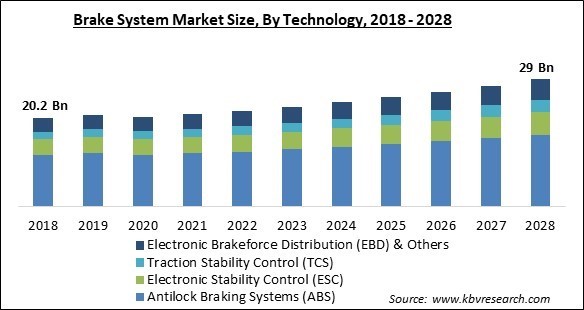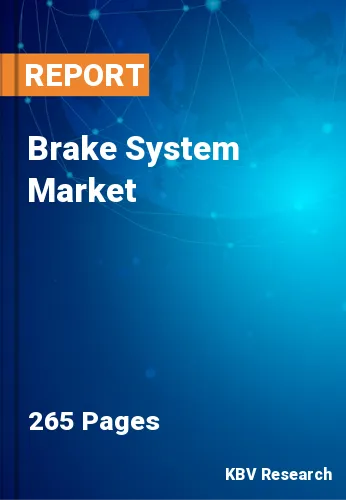The Global Brake System Market size is expected to reach $29 billion by 2028, rising at a market growth of 4.9% CAGR during the forecast period.
A braking system is a technique that is used to stop a vehicle's motion. Brakes typically use friction between two surfaces to transform the vehicle's kinetic energy into heat, which then causes the vehicle to stop. The mechanism that uses artificial resistance to slow down or stop a moving body can also be referred to as brake system. To create the friction needed to stop the vehicle, various methods are employed.

The management of heat energy created, which otherwise could harm the vehicle or the brake system, is the most crucial consideration when building any brake system. The brakes have two unique purposes. The first thing to do in an emergency is to stop or slow down the car as quickly as possible. The second is to retain vehicle control when going down a hill. While the second function calls for brakes that can disperse a lot of heat without causing significant temperature increases, the first function calls for brakes that can impart considerable braking torques to the brake drums.
Because of the surge in demand for both passenger and commercial vehicles, the market for brake systems is anticipated to grow dramatically. The acceptance of luxury cars, the adoption of severe safety regulations, and the rising use of disc brakes in commercial vehicles are all contributing to the market's expansion. Additionally, only a certain number of kilometres can be covered by brake components before they need to be replaced, which is driving up interconnected markets as well.
The brake system market endured severely negative impacts of the pandemic. COVID-19's effects included a lack of materials and subcontractors, disruptions in the supply chain, and contract terminations in an effort to reduce costs. Worldwide operations were impacted by public and commercial sector laws and measures to reduce COVID-19 transmissions, such as travel limitations and the adoption of remote working. The national government's trade restrictions, export limitations, and other similar measures also had a negative impact on the marketability of a number of goods. The ability of suppliers and vendors to provide goods and services was similarly impacted by COVID-19.
The stopping distance can be decreased by using electronic braking systems such as Brake Assist (BA), Anti-lock Brake Systems (ABS), and Electronic Brakeforce Distribution (EBD). ABS helps shorten stopping distances when braking forcefully by enabling stability of the vehicle and directional control. This is only one of the many benefits ABS has over traditional braking systems. The Royal Society for the Prevention of Accidents (ROSPA) claims that ABS guarantees the achievement of the smallest distance at which a vehicle can come to a stop. BA is typically used in conjunction with ABS and is dependent on the vehicle's ABS technology.
A draft of United Nations regulation regarding advanced emergency braking (AEB) systems for cars and light trucks was approved by more than 40 nations in 2019 with the goal of reducing vehicle collisions. The EU's Regulation No. 152-00 for AEB systems in light passenger and commercial cars has been changed. According to the rule, AEB must be standard equipment on all new vehicles. Additionally, the legislation requires the testing of vehicles at 60 mph to verify the deployment of AEB systems. AEB systems are becoming more and more common, largely as a result of government regulations requiring them as standard equipment in new car models.
The cost of routine brake system maintenance includes replacing brake fluid, brake shoes, and brake pads, resurfacing rotors, cleaning, adjusting, and lubricating other costly braking components, as well as performing general brake system maintenance. Given that the sensors on each wheel might cost hundreds of dollars, maintaining an ABS is expensive. For instance, Repair Smith estimates that the typical cost to replace an ABS sensor is between $150 and $400 and the average cost to replace brake fluid is between $90 and $200. Additionally, it can cost between USD 750 and $1,000 to repair crucial parts such as master cylinders, rotors, calipers, drums, pads, and cylinders.
On the basis of technology, the brake system market is segmented into Antilock Braking Systems (ABS), Electronic Stability Control (ESC), Traction Stability Control (TCS), and Electronic Brakeforce Distribution (EBD). The Electronic Stability Control segment recorded a substantial revenue share in the brake system market in 2021. The ESC is a crucial safety feature that stops dangerous vehicle conditions from occurring. Additionally, ESC is a requirement for other safety innovations like driver assistance systems. The ESC system continuously analyses the driver's input with the actual behaviour of the vehicle using data from the steering angle sensor, wheel speed sensors, yaw rate, and lateral acceleration sensor.

On the basis of actuation, the brake system market is classified into hydraulic and pneumatic. The hydraulic actuation acquired the largest revenue share in the brake system market in 2021. The popularity of hydraulic brake systems is rising as both the production of passenger automobiles and light commercial vehicles (LCV) rise. During the forecast period, hydraulic brake systems are expected to expand due to benefits such as superior heat dissipation compared to mechanical brakes, improved braking power transmission, compact size, and ease of repair due to easily available brake parts in the aftermarket.
Based on brake type, the brake system market is bifurcated into disc and drum. The Drum brake segment recorded a significant revenue share in the brake system market in 2021. Drum brakes are brakes where the inside surface of the drum is pressed against the shoes. Although such brakes are extremely uncommon, they are occasionally referred to as "pinch drum brakes" when the drum is pinched between two shoes, much like a typical disc brake. These can easily be used with disc brakes. As they are comparatively economical, a majority of vehicles make use of them.
Based on vehicle type, the brake system market is categorized into passenger car, Light-commercial Vehicles (LCV), truck, and bus. The passenger cars segment acquired the highest revenue share in the brake system market in 2021. A passenger car is a vehicle that is used to transport people and has a maximum seating capacity of nine people (including the driver). Passenger automobile includes microcars, taxis, and rented passenger cars. In many parts of the world, passenger vehicles are the predominant form of road transportation.
| Report Attribute | Details |
|---|---|
| Market size value in 2021 | USD 21 Billion |
| Market size forecast in 2028 | USD 29 Billion |
| Base Year | 2021 |
| Historical Period | 2018 to 2020 |
| Forecast Period | 2022 to 2028 |
| Revenue Growth Rate | CAGR of 4.9% from 2022 to 2028 |
| Number of Pages | 265 |
| Number of Tables | 440 |
| Report coverage | Market Trends, Revenue Estimation and Forecast, Segmentation Analysis, Regional and Country Breakdown, Companies Strategic Developments, Company Profiling |
| Segments covered | Technology, Actuation, Brake Type, Vehicle Type, Region |
| Country scope | US, Canada, Mexico, Germany, UK, France, Russia, Spain, Italy, China, Japan, India, South Korea, Australia, Malaysia, Brazil, Argentina, UAE, Saudi Arabia, South Africa, Nigeria |
| Growth Drivers |
|
| Restraints |
|
On the basis of region, the brake system market is analyzed across North America, Europe, Asia Pacific, and LAMEA. The Asia Pacific region procured the highest revenue share in the brake system market in 2021. The growing prevalence of usage of passenger cars is the main force behind the growth of this segment. The increasing customer preference for cars with automated brakes, SUVs, and trucks is pushing the market forward. These are supported by the rise in companies launching new vehicles and electric vehicles in the region.
Free Valuable Insights: Global Brake System Market size to reach USD 29 Billion by 2028
The market research report covers the analysis of key stake holders of the market. Key companies profiled in the report include Robert Bosch GmbH, Knorr-Bremse AG, Brembo S.p.A., Continental AG, Hitachi, Ltd. (Hitachi Astemo, Ltd.), Denso Corporation, ZF Friedrichshafen AG, Aisin Corporation, Haldex AB and Mando Corporation (Halla Group).
By Technology
By Actuation
By Brake Type
By Vehicle Type
By Geography
The global Brake System Market size is expected to reach $29 billion by 2028.
Addition of cutting-edge braking systems like ABS and EBD to improve vehicle safety are driving the market in coming years, however, High expenditures of developing and maintaining superior braking technology restraints the growth of the market.
Robert Bosch GmbH, Knorr-Bremse AG, Brembo S.p.A., Continental AG, Hitachi, Ltd. (Hitachi Astemo, Ltd.), Denso Corporation, ZF Friedrichshafen AG, Aisin Corporation, Haldex AB and Mando Corporation (Halla Group).
The expected CAGR of the Brake System Market is 4.9% from 2022 to 2028.
The Antilock Braking Systems (ABS) market acquired the highest revenue share in the Global Brake System Market by Technology in 2021, thereby, achieving a market value of $16.3 billion by 2028.
The Asia Pacific market dominated the Global Brake System Market by Region in 2021, and would continue to be a dominant market till 2028; thereby, achieving a market value of $10.3 billion by 2028.
Our team of dedicated experts can provide you with attractive expansion opportunities for your business.

